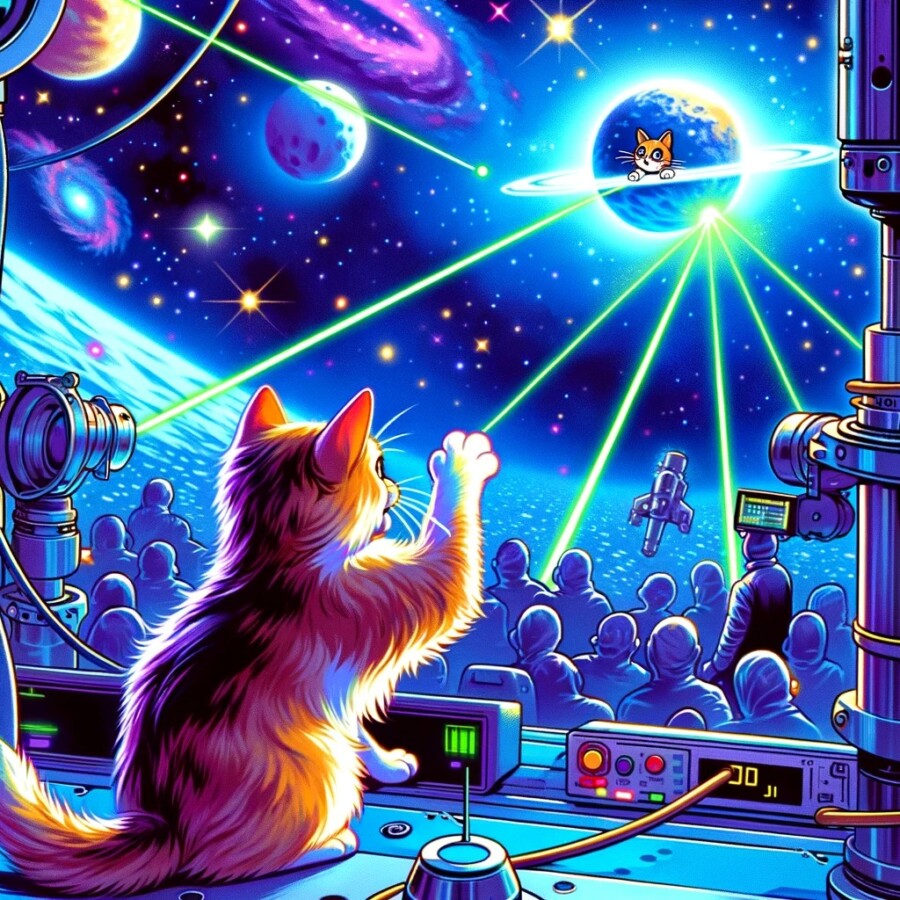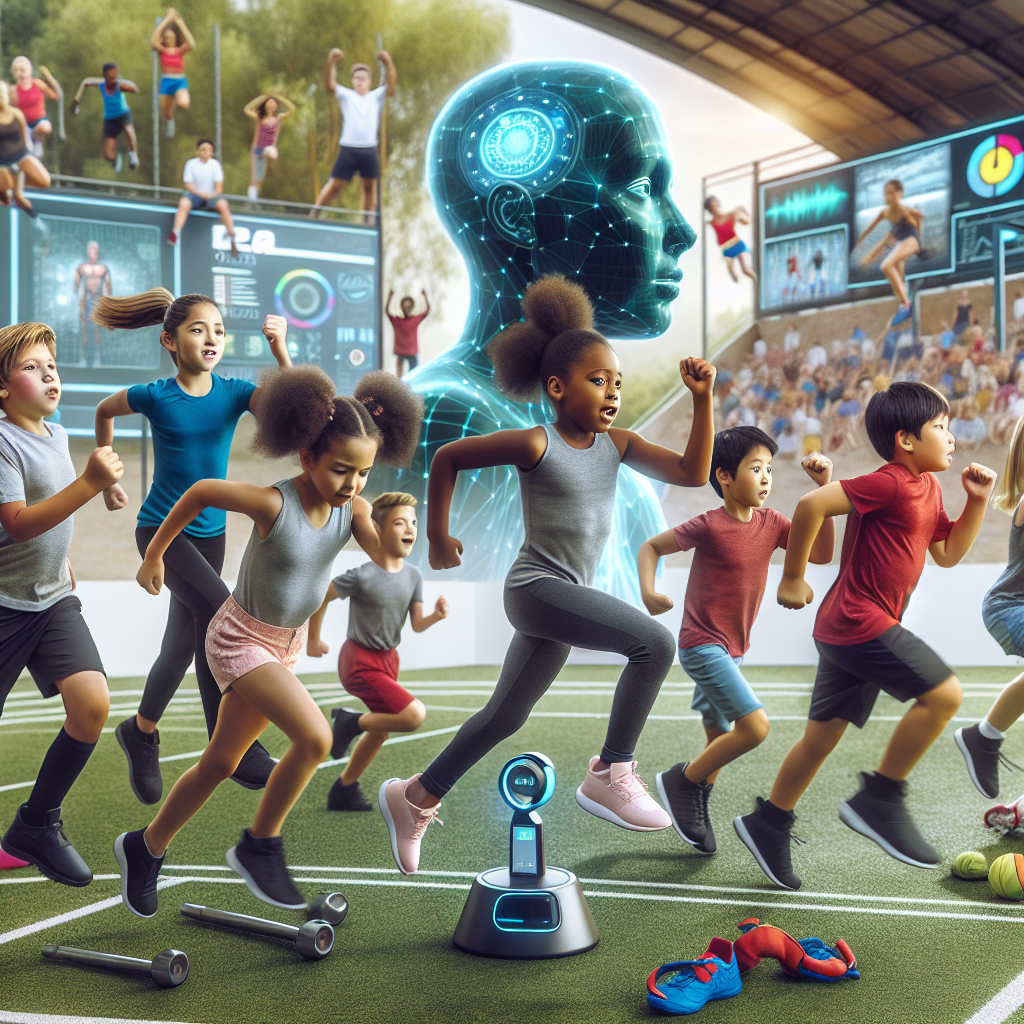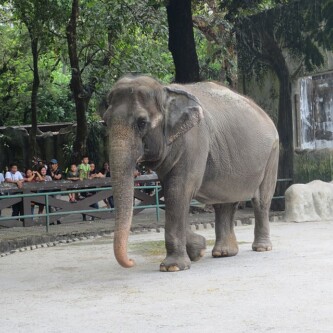Nasa recently did something really cool – they streamed a high-definition video of a cat from space back to Earth! The video showed a cat named Taters chasing a laser beam. What’s even more amazing is that the video traveled a whopping 19 million miles, which is like going to the Moon and back 80 times! Nasa did this to test a new laser technology that could help us communicate better with faraway parts of our solar system. Taters, the star of the video, belongs to someone who works at Nasa’s Jet Propulsion Laboratory in California. The video was uploaded to a spacecraft launched by SpaceX and was streamed on 11 December.
Even though the video had to travel such a long distance, it was actually transmitted faster than most internet connections we have on Earth! It was received by a telescope at the Palomar observatory and then downloaded. From there, it was streamed to the Jet Propulsion Laboratory and played in real-time. The connection between the observatory and the laboratory was slower than the signal sending the video from space. Nasa’s DesignLab played a big role in showing off this technology, and everyone involved was really happy that the experiment was a success.
You can find the video on YouTube, and it’s pretty cool. They made it special by adding information about the mission and details about Taters, like what breed he is, his heart rate, and his age. This project is part of Nasa’s mission to explore communication in deep space. They’re trying to find ways to send more data from faraway places to Earth. Radio frequencies have a hard time sending high-quality images and videos over long distances, so Nasa is working on using lasers to make communication better. They want to have more bandwidth to achieve their future exploration and science goals.
Nasa’s achievement in sending a cat video from space using lasers is a big deal. It could change how we communicate during missions to other planets and help us send more data during space exploration. By pushing the limits of laser communication, Nasa is making it easier to talk to faraway parts of our solar system.
Original news source: Nasa beams cat video from deep space with laser (BBC)
🎧 Listen:
Slow
Normal
Fast
📖 Vocabulary:
| 1 | streamed | Sent or played over the internet in a continuous flow |
| 2 | laser | A device that emits a very strong, precise beam of light |
| 3 | whopping | Extremely large or great |
| 4 | spacecraft | A vehicle designed for travel or operation in outer space |
| 5 | transmitted | Sent or passed from one place to another |
| 6 | observatory | A building equipped with a telescope for observing celestial events |
| 7 | real-time | Happening or done at the same moment as events occur, without any delay |
| 8 | bandwidth | The amount of data that can be sent through a connection at one time |
| 9 | frequencies | Invisible waves that are used to send signals for radio, television, and cell phones |
| 10 | exploration | The act of traveling through an unfamiliar area to learn about it |
| 11 | propulsion | The mechanism or technology used to move a vehicle, especially a rocket or spacecraft |
| 12 | achievement | A significant success or noteworthy accomplishment, especially through hard work or skill |
| 13 | communication | The act of sharing or exchanging information, news, or ideas |
| 14 | technology | The practical application of scientific knowledge for practical purposes, especially in industry |
| 15 | bandwidth | The capacity for transferring data over a network at a given time |
Group or Classroom Activities
Warm-up Activities:
– News Summary
Instructions:
1. Divide the class into pairs or small groups.
2. Provide each group with a copy of the article.
3. Instruct the groups to read the article and summarize it in their own words.
4. Each group should then present their summary to the class.
5. Encourage discussion and ask follow-up questions to check comprehension.
– Vocabulary Pictionary
Instructions:
1. Write down key vocabulary words from the article on separate pieces of paper and put them in a hat or bowl.
2. Divide the class into teams.
3. One student from each team will take turns picking a word from the hat and drawing it on the board.
4. The team members must guess the word within a time limit.
5. The team with the most correct guesses wins.
– Think-Pair-Share
Instructions:
1. Ask the students to think about and write down their thoughts on the following question: “How do you think the use of laser technology in space communication could benefit future space exploration?”
2. Pair the students up and give them a few minutes to discuss their ideas with their partner.
3. After the discussion, ask each pair to share their thoughts with the rest of the class.
4. Encourage further discussion and ask follow-up questions to promote critical thinking and analysis.
– Charades
Instructions:
1. Write down key words or phrases related to the article on separate pieces of paper and put them in a hat or bowl.
2. Divide the class into teams.
3. One student from each team will take turns picking a word or phrase from the hat and acting it out without speaking.
4. The team members must guess the word or phrase within a time limit.
5. The team with the most correct guesses wins.
– Future Predictions
Instructions:
1. Instruct the students to brainstorm and write down their predictions for how communication in space will evolve in the future.
2. Divide the class into small groups and have them discuss their predictions.
3. Each group should choose a spokesperson to present their predictions to the class.
4. Encourage discussion and ask follow-up questions to promote critical thinking and creativity.
🤔 Comprehension Questions:
1. What did NASA do recently that was really cool?
2. Who was the star of the video that NASA streamed from space?
3. How far did the video travel from space back to Earth?
4. Why did NASA stream the video of the cat from space?
5. How was the video transmitted faster than most internet connections on Earth?
6. Where was the video received and downloaded before being streamed to the Jet Propulsion Laboratory?
7. What information was added to the video on YouTube?
8. Why is NASA working on using lasers for communication in deep space?
Go to answers ⇩
🎧✍️ Listen and Fill in the Gaps:
Nasa recently did something really cool – they (1)______ a high-definition video of a cat from space back to Earth! The video showed a cat named Taters (2)______ a laser beam. What’s even more amazing is that the video traveled a whopping 19 million miles, which is like (3)______ to the Moon and back 80 times! Nasa did this to test a new laser technology that could help us communicate better with faraway parts of our solar (4)______. Taters, the star of the video, belongs to someone who works at Nasa’s Jet Propulsion Laboratory in California. The video was uploaded to a (5)______ launched by SpaceX and was streamed on 11 December.
Even though the video had to (6)______ such a long distance, it was actually transmitted faster than most internet (7)______ we have on Earth! It was received by a telescope at the Palomar observatory and then downloaded. From there, it was streamed to the Jet Propulsion (8)______ and played in real-time. The connection between the observatory and the laboratory was slower than the signal sending the video from space. Nasa’s DesignLab played a big role in showing off this technology, and everyone involved was really happy that the experiment was a success.
You can find the video on YouTube, and it’s pretty cool. They made it (9)______ by adding information about the (10)______ and (11)______ about Taters, like what breed he is, his heart rate, and his age. This project is part of Nasa’s mission to explore communication in deep space. They’re trying to find ways to send more data from faraway places to Earth. Radio (12)______ have a hard time sending high-quality (13)______ and videos over long distances, so Nasa is working on using lasers to make communication better. They want to have more bandwidth to achieve their future exploration and science (14)______.
Nasa’s achievement in sending a cat video from space using lasers is a big deal. It could (15)______ how we communicate during missions to other planets and help us send more data during space exploration. By pushing the (16)______ of laser communication, Nasa is making it easier to talk to faraway parts of our solar system.
Go to answers ⇩
💬 Discussion Questions:
Students can ask a partner these questions, or discuss them as a group.
1. What do you think about Nasa streaming a video of a cat from space?
2. How would you feel if you could communicate with someone on another planet?
3. Do you like watching videos of animals? Why or why not?
4. Do you think it’s important for Nasa to find better ways to communicate with faraway parts of our solar system? Why or why not?
5. How do you think the new laser technology could be useful in space exploration?
6. Have you ever seen a laser beam? What was your experience like?
7. What do you think it would be like to work at Nasa’s Jet Propulsion Laboratory in California?
8. How do you think the cat, Taters, felt when he was chasing the laser beam in space?
9. Do you think it’s impressive that the video traveled a distance equivalent to going to the Moon and back 80 times? Why or why not?
10. How do you think the technology used to transmit the video from space is different from our internet connections on Earth?
11. Do you think it’s important for Nasa to share their experiments and achievements with the public? Why or why not?
12. What other types of information do you think could be added to a video like this to make it more interesting?
13. How do you think laser communication could impact future space missions?
14. Have you ever used a telescope? What did you see?
15. Do you think it’s possible to communicate with intelligent life on other planets? Why or why not?
Individual Activities
📖💭 Vocabulary Meanings:
Match each word to its meaning.
Words:
1. streamed
2. laser
3. whopping
4. spacecraft
5. transmitted
6. observatory
7. real-time
8. bandwidth
9. frequencies
10. exploration
11. propulsion
12. achievement
13. communication
14. technology
15. bandwidth
Meanings:
(A) The act of sharing or exchanging information, news, or ideas
(B) Sent or passed from one place to another
(C) The capacity for transferring data over a network at a given time
(D) A device that emits a very strong, precise beam of light
(E) The mechanism or technology used to move a vehicle, especially a rocket or spacecraft
(F) Sent or played over the internet in a continuous flow
(G) The act of traveling through an unfamiliar area to learn about it
(H) The practical application of scientific knowledge for practical purposes, especially in industry
(I) A significant success or noteworthy accomplishment, especially through hard work or skill
(J) Extremely large or great
(K) Invisible waves that are used to send signals for radio, television, and cell phones
(L) Happening or done at the same moment as events occur, without any delay
(M) The amount of data that can be sent through a connection at one time
(N) A vehicle designed for travel or operation in outer space
(O) A building equipped with a telescope for observing celestial events
Go to answers ⇩
🔡 Multiple Choice Questions:
1. What did Nasa recently stream from space back to Earth?
(a) A live stream of a rocket launch
(b) A high-definition video of a cat
(c) A documentary about space exploration
(d) A music concert
2. How far did the video travel from space to Earth?
(a) 100,000 miles
(b) 1 million miles
(c) 10,000 miles
(d) 19 million miles
3. What technology did Nasa test with this video?
(a) Laser technology
(b) Radio technology
(c) Satellite technology
(d) Internet technology
4. Where does Taters, the cat in the video, belong to?
(a) A famous astronaut
(b) Someone who works at Nasa’s Jet Propulsion Laboratory
(c) A scientist studying space communication
(d) A regular person
5. How was the video transmitted to Earth?
(a) Through a satellite in space
(b) Through a cable connected to the spacecraft
(c) Through a telescope at the Palomar observatory
(d) Through a radio signal
6. Why is Nasa working on using lasers for communication in space?
(a) Radio frequencies have difficulty sending high-quality images and videos over long distances
(b) Lasers are faster than radio signals
(c) Lasers are more reliable than radio signals
(d) Lasers are cheaper to use than radio signals
7. What is Nasa’s mission in exploring communication in deep space?
(a) To discover new planets
(b) To train astronauts for future missions
(c) To build more powerful telescopes
(d) To find ways to send more data from faraway places to Earth
8. How could Nasa’s achievement in laser communication change space exploration?
(a) It could make it easier to communicate with other planets
(b) It could revolutionize how we communicate during space exploration
(c) It could help us send more data during space missions
(d) All of the above
Go to answers ⇩
🕵️ True or False Questions:
1. The video was downloaded from a spacecraft launched by SpaceX and streamed on 11 December.
2. The video was transmitted slower than most internet connections on Earth.
3. The video showed a dog named Taters chasing a laser beam.
4. The video traveled a distance of 19 million miles, equivalent to going to the Moon and back 90 times.
5. Nasa’s DesignLab played a significant role in showcasing this technology, and the experiment was successful.
6. Taters, the cat in the video, belongs to someone who works at Nasa’s Jet Propulsion Laboratory in California.
7. Nasa streamed a high-definition video of a cat from space back to Earth.
8. Nasa conducted this experiment to test a new laser technology for better communication with distant parts of our solar system.
Go to answers ⇩
📝 Write a Summary:
Write a summary of this news article in two sentences.
Check your writing now with the best free AI for English writing!
Writing Questions:
Answer the following questions. Write as much as you can for each answer.
Check your answers with our free English writing assistant!
1. What did Nasa recently do that was really cool?
2. How far did the video of the cat from space travel?
3. Why did Nasa stream the video of the cat from space?
4. How was the video transmitted back to Earth?
5. Why is Nasa working on using lasers for communication in deep space?
✅ Answers
🤔✅ Comprehension Question Answers:
1. What did NASA do recently that was really cool?
NASA streamed a high-definition video of a cat from space back to Earth.
2. Who was the star of the video that NASA streamed from space?
The star of the video was a cat named Taters.
3. How far did the video travel from space back to Earth?
The video traveled a whopping 19 million miles.
4. Why did NASA stream the video of the cat from space?
NASA streamed the video to test a new laser technology that could help us communicate better with faraway parts of our solar system.
5. How was the video transmitted faster than most internet connections on Earth?
The video was transmitted faster because it was sent using laser technology, which is faster than radio frequencies.
6. Where was the video received and downloaded before being streamed to the Jet Propulsion Laboratory?
The video was received and downloaded at the Palomar observatory.
7. What information was added to the video on YouTube?
Information about the mission and details about Taters, like his breed, heart rate, and age, were added to the video on YouTube.
8. Why is NASA working on using lasers for communication in deep space?
NASA is working on using lasers because radio frequencies have a hard time sending high-quality images and videos over long distances, and lasers could provide more bandwidth for better communication during space exploration.
Go back to questions ⇧
🎧✍️✅ Listen and Fill in the Gaps Answers:
(1) streamed
(2) chasing
(3) going
(4) system
(5) spacecraft
(6) travel
(7) connections
(8) Laboratory
(9) special
(10) mission
(11) details
(12) frequencies
(13) images
(14) goals
(15) change
(16) limits
Go back to questions ⇧
📖💭✅ Vocabulary Meanings Answers:
1. streamed
Answer: (F) Sent or played over the internet in a continuous flow
2. laser
Answer: (D) A device that emits a very strong, precise beam of light
3. whopping
Answer: (J) Extremely large or great
4. spacecraft
Answer: (N) A vehicle designed for travel or operation in outer space
5. transmitted
Answer: (B) Sent or passed from one place to another
6. observatory
Answer: (O) A building equipped with a telescope for observing celestial events
7. real-time
Answer: (L) Happening or done at the same moment as events occur, without any delay
8. bandwidth
Answer: (M) The amount of data that can be sent through a connection at one time
9. frequencies
Answer: (K) Invisible waves that are used to send signals for radio, television, and cell phones
10. exploration
Answer: (G) The act of traveling through an unfamiliar area to learn about it
11. propulsion
Answer: (E) The mechanism or technology used to move a vehicle, especially a rocket or spacecraft
12. achievement
Answer: (I) A significant success or noteworthy accomplishment, especially through hard work or skill
13. communication
Answer: (A) The act of sharing or exchanging information, news, or ideas
14. technology
Answer: (H) The practical application of scientific knowledge for practical purposes, especially in industry
15. bandwidth
Answer: (C) The capacity for transferring data over a network at a given time
Go back to questions ⇧
🔡✅ Multiple Choice Answers:
1. What did Nasa recently stream from space back to Earth?
Answer: (b) A high-definition video of a cat
2. How far did the video travel from space to Earth?
Answer: (d) 19 million miles
3. What technology did Nasa test with this video?
Answer: (a) Laser technology
4. Where does Taters, the cat in the video, belong to?
Answer: (b) Someone who works at Nasa’s Jet Propulsion Laboratory
5. How was the video transmitted to Earth?
Answer: (c) Through a telescope at the Palomar observatory
6. Why is Nasa working on using lasers for communication in space?
Answer: (a) Radio frequencies have difficulty sending high-quality images and videos over long distances
7. What is Nasa’s mission in exploring communication in deep space?
Answer: (d) To find ways to send more data from faraway places to Earth
8. How could Nasa’s achievement in laser communication change space exploration?
Answer: (c) It could help us send more data during space missions
Go back to questions ⇧
🕵️✅ True or False Answers:
1. The video was downloaded from a spacecraft launched by SpaceX and streamed on 11 December. (Answer: False)
2. The video was transmitted slower than most internet connections on Earth. (Answer: False)
3. The video showed a dog named Taters chasing a laser beam. (Answer: False)
4. The video traveled a distance of 19 million miles, equivalent to going to the Moon and back 90 times. (Answer: False)
5. Nasa’s DesignLab played a significant role in showcasing this technology, and the experiment was successful. (Answer: True)
6. Taters, the cat in the video, belongs to someone who works at Nasa’s Jet Propulsion Laboratory in California. (Answer: True)
7. Nasa streamed a high-definition video of a cat from space back to Earth. (Answer: True)
8. Nasa conducted this experiment to test a new laser technology for better communication with distant parts of our solar system. (Answer: True)
Go back to questions ⇧













